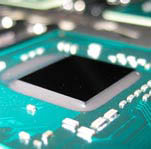封装中的测量与检验应用

作者:George T. Ayoub 博士,MVP 公司总裁兼首席执行官
高速 AOI 检测解决方案在过去 20 多年中已在多个行业领域获得了广泛认可,例如传统 SMT、汽车行业和 PCB 制造业。其创新的解决方案、内建的高质量、可靠性、低维护需求以及先进的高速检测能力,吸引了全球众多行业领先企业以及高产量制造巨头的采用。
去年,MVP 推出了另一条创新产品线,这些产品已在电子行业的多个领域彻底革新了 AOI 技术。面向封装应用,这一新平台旨在满足并超越当今复杂的高产量制造(HVM)装配需求。由于平台可配置性强,使其成为复杂及混合 C4 + SMT 装配线中多种应用的高速 AOI 理想选择。
♦ 针对封装应用的新型检测平台
市场对新型电子产品的需求增长迅速,对更精巧的外观、更强的移动性以及更高的集成功能的需求不断提升。严格的设计要求推动体积在三维空间持续缩小。而集成功能的增加,则推动 SMT 元件的种类增多、特征尺寸缩小、封装高度降低。这样的趋势为产品集成带来了重大挑战,尤其是在封装装配领域。
具备实时检测能力,并能提供适当的“反馈钩子”以输出有意义且易于理解的信息,使复杂的装配线能更高效地管理上下游流程,例如产线合格率、设备利用率、整体生产效率及盈利能力。该平台正是为满足上述因素而设计,以应对当今及未来的 AOI 需求。
根据应用需求,平台可配置不同的电光学系统与/或物料处理系统,以满足多种加工要求。但所有应用均基于同一平台架构。不同配置间的共通性显著提高复杂装配线的整体利用率。经过基本培训后,设备操作员可以在不同工站之间快速转换,因为所有配置共享相同的操作系统与用户界面。其他重要优势包括备件管理与设备维护。由于绝大多数组件在所有配置中均可共用,备件库存数量减少,问题排查更容易,定期维护也得以简化。
所有配置均配备高稳定性的花岗岩平台,以提高整体检测精度。高精度框架与花岗岩平台配套使用,配合单个 400 万像素彩色相机与可编程 LED 光源,可实现高速在线图像采集,视野分辨率可达 3–25 μm/像素。可选装远心镜头,以进一步提升特定应用所需的检测精度。
物料处理系统经过精心设计,以确保最大灵活性,并兼容 JEDEC 料盘、金属载具、裸 PCB 以及薄片加工需求。所有平台均可配置为单轨或双轨。为了更精准的板材定位与处理,可选配支撑平台与自动夹板系统。平台并充分考虑了上下游通信需求,支持灵活的 PLC 控制、SMEMA 接口以及全自动化能力,可将工具性能与特定工艺配方数据传输至产线管理服务器。
平台配备功能强大的集成 SPC 模块。大量有价值的检测结果会被持续收集,并可实时绘制成多种图表格式,帮助故障分析并维持高良率的装配线。提供离线编程与调试功能,以最大限度减少生产中断。基于 CAD 的库式编程软件则大幅缩短新配方的创建与测试时间。
随着封装技术的不断发展,尤其是有机封装与薄型封装工艺的兴起,对 AOI 的需求持续增长。MVP 850G 平台正是为满足当前与下一代封装装配需求而专门设计的。该工具可配置用于执行:3D 锡膏检测、无需荧光添加剂的 2D 助焊剂检测、C4 Die 及 SMT 元件前后回流检测、C4 环氧底填(扩散、质量、焊趾等)检测、表面缺陷(划痕、损伤等)检测、键合线检测、胶水与密封剂检测、传统 SMT(前/后回流)检测等多种应用。平台可根据装配布局与工艺要求选择在线或离线模式。
♦ Die 放置测量系统(Die Placement Metrology System)

MVP 曾受某主要客户委托,开发一套能对贴装在基板上的 Die 进行高精度测量与检测的解决方案。由于 Die 的贴装精度直接关系到产品的可靠性,MVP 工程团队与管理层因此启动了一项开发高精度测量及检测工具的项目。
系统必须是一套稳健的计量型解决方案,其能力要求包括:
-
X/Y 平移重复性:1.3 μm
-
X/Y 平移再现性:< 2 μm
-
旋转角度重复性及再现性:≤ 0.007°
-
不同机台之间的整体测量精度差异:≤ 10 μm
凭借多年在多个行业领域积累的检测经验,项目团队着手定义能满足客户要求的新型检测工具。该工具不仅要能在回流前后检测 Die 的贴装情况,还需能够检测 Die 表面的划痕与不规则缺陷。
系统必须额外支持检测如下表面贴装元件:0204、0201、0603 IDC、0402、阻值网络,甚至脚距达 12 mil 的 QFP。

为了满足这些需求,团队开发了专有电光学模块。分辨率研究显示,16 μm 像素尺寸足以在速度与精度之间取得平衡。电光学模块采用远心镜头,并配备三色光源与白光源,从而确保表面贴装缺陷清晰可见,同时提高边缘信噪比。
平台软件内置多种检测算法,包括亚像素边缘检测、表面缺陷检测、SMT 回流前后检测以及计量算法。
另一个重大挑战是检测节拍要求。系统必须实现每小时 3000–4000 UPH 的处理能力。为达到这一目标,系统采用并行的基准点识别与检测策略,从而在检测周期中大幅节省时间。
系统还要求具备双轨功能,以便与现有生产设备配套运行,实现整线 UPH 不下降。进一步的挑战包括:系统需支持 SECS/GEM 与批次代码(Lot)追溯功能。
系统可用率也是关键参数,最低要求为 98.5%。平台不仅达成了该标准,实际表现超过 99%。
接下来的图表展示了平台如何不仅满足客户规格,而且大幅超越规格。
♦ 重复性与再现性 Sigma 指标



♦ 与基准系统比对测试
下图展示了某一计量系统的结果。对 16 个具有不同 X 偏移量的 Die 进行测量,并分别使用基准系统与新的 Die 贴装计量系统进行评估。线性回归拟合得到的斜率为 1.032,R² 值为 0.99。偏差(Bias)为 1.4147 μm。


MVP 不仅成功交付了首台工具,并且随后向同一客户提供了 50 多套类似系统,这些系统均通过了严格的测试程序才被正式验收。
随着从传统 SMT 检测向微电子检测能力的拓展,MVP 再次证明了其优势在于高性能、灵活且创新的检测解决方案。
